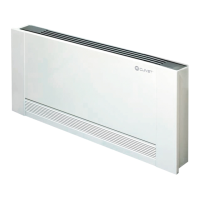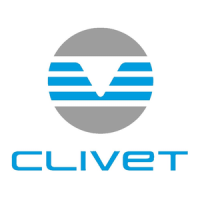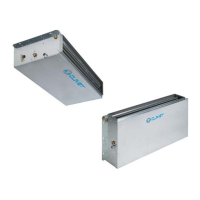
Do you have a question about the CLIVET ELFORoom2 003.0 and is the answer not in the manual?
| Brand | CLIVET |
|---|---|
| Model | ELFORoom2 003.0 |
| Category | Touch terminals |
| Language | English |
Provides unit installation, use, and maintenance guidance for users.
Guidelines for operating the unit safely and according to regulations.
Instructions for manual storage and tracking interventions.
Essential safety rules for using products with electricity and water.
Explains the serial number label and its reported data for unit identification.
Shows different unit versions: Vertical and Horizontal.
Lists various accessories available for the unit with their codes.
General operating compliance and information required for unit reception.
Checks to perform before accepting delivery for damage or anomalies.
Safety instructions for handling the unit during transport.
General operating compliance and information for unit positioning.
Details functional spaces required for unit operation and maintenance.
Advises on optimal and suboptimal installation locations.
Describes mounting phases and designs for left/right fixtures.
Step-by-step instructions for side opening operations.
Instructions for mounting the unit horizontally or on the ceiling.
Instructions for installing the unit vertically on floors or walls.
Specifies pipeline diameters for water inlet, outlet, and condensate.
Guidelines for choosing and sizing hydraulic lines correctly.
Requirements for condensation discharge network sizing and positioning.
Steps for mounting horizontal bowl and pipe connections.
Steps for connecting vertical condensation collection tray.
Explains operations for rotating fixtures for left/right side.
Instructions for dismounting various panels of the unit.
Detailed steps to dismount the control panel and related components.
Detailed steps for rotating the coil for right-side connections.
Instructions for connecting motor kit cables for accessories.
Step-by-step procedure for filling the hydraulic system correctly.
Instructions for correctly mounting the insulating panel.
Instructions for mounting front grill safety support clamps.
Electrical line characteristics and required personnel qualifications.
Location of unit specific electrical data on the serial number label.
Steps for making unit electrical connections and ensuring proper earthing.
Guidelines for laying signal/data cables and avoiding interference.
Instructions for safely accessing the unit's electrical panel.
Wiring diagram for connecting a room thermostat mounted on-board.
Wiring diagrams for connecting HID-Txx electronic room thermostats.
Diagram for connecting multiple ELFORoom units in a mini-network.
Description of ELFOSystem GAIA Edition components and system zones.
Wiring diagram for connecting a 4-speed electronic control unit.
Connection diagrams for HID-E1 and HID-E2 thermostats in 2-pipe systems.
Wiring diagram for the HID-E2 thermostat in a 4-pipe system.
Wiring diagram for the HID-E3 thermostat in a 2-pipe system.
Wiring diagram for the HID-E3 thermostat in a 4-pipe system.
Explanation of the green LED status and various alarm fault conditions.
Wiring diagram for the SC010 0-10V modulating fan control.
Diagram showing optional radiant connections for 2-pipe systems.
Explains the display and keys of the built-in electronic thermostat.
How to activate and use automatic ventilation speed regulation.
How to set the desired room temperature using the control buttons.
How to activate and use the night functioning mode.
How to activate and use the silent function mode.
How to switch between heating and cooling operating modes.
How to activate the maximum ventilation speed mode.
Lists and explains common alarm codes (E1, E2, E3, GR).
How installers can activate automatic cooling/heating regulation.
How to use the CP presence contact input for standby operation.
How installers can adjust the ambient temperature probe reading.
How the control manages ambient temperature with 4 fan speeds.
How to switch between heating and cooling modes.
How to select fan speed manually or automatically.
How to set and adjust the desired room temperature.
How to adjust or turn off the control panel brightness.
How to activate and deactivate the thermostat's keypad lock.
Explains the green LED status and various alarm fault conditions.
How to set auxiliary functions using the control panel's dip-switches.
Procedure for safely shutting down the unit for extended periods.
Details optional functions and operations for HID-T2/T3 thermostats.
How to switch the thermostat ON/OFF and modify set-point values.
How to view room temperature and humidity readings on the display.
How to activate the night functioning mode via the control.
How to manually set the fan speed instead of automatic adjustment.
How to activate and deactivate the silent mode on the thermostat.
Table of alarms, their descriptions, and reset procedures.
Details optional features and operations for the HID-Ti2 thermostat.
How to manage fan speed in various operational modes.
How to activate the silenced mode on the thermostat.
How to lock and unlock the thermostat's keypad to prevent changes.
Notes that night functioning is not available with HID-Ti2 thermostats.
Explains the importance of routine maintenance for safety and reliability.
Provides recommended intervals for performing unit inspections.
Step-by-step instructions for cleaning the unit's outer surfaces.
Steps to extract filter cells from units equipped with aspiration.
Steps to extract filter cells from units with a mobile aspiration panel.
Instructions for cleaning the filter seats after filter removal.
Final steps for reassembling unit components after cleaning.
Lists common unit anomalies, their causes, and recommended remedies.
Provides dimensional data for uncased and cased 2-pipe unit versions.
Provides dimensional data for uncased and cased 4-pipe unit versions.
Technical specifications for cooling, heating, and air handling sections.
Electrical data including FLA and FLI for different unit sizes.
Operating limits for the internal exchanger during heating mode.
Operating limits for the internal exchanger during cooling mode.
Sound power and pressure levels measured at different fan speeds.
General safety measures, handling, installation, and risk awareness.
Risks associated with electrical components and moving parts.
Risks from water leaks and defects in the hydraulic system.
Procedure for disconnecting the unit and recovering refrigerant/solutions.
How to dismantle and dispose of the unit via authorized centers.
Information on EC WEEE directive for waste electrical equipment disposal.











